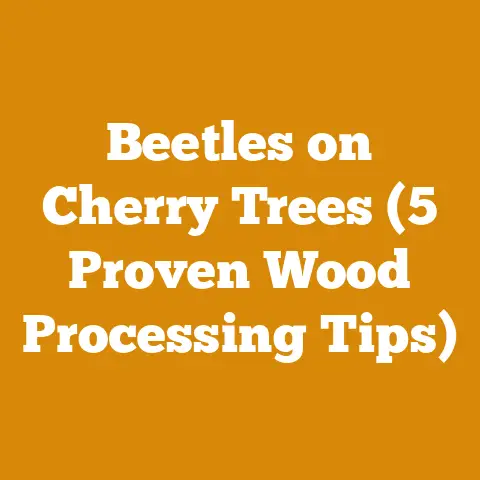Root System of Weeping Cherry Tree (5 Expert Tips for Safe Planting)
Have you ever considered the silent, sprawling architecture beneath a weeping cherry tree, a foundation as crucial to its graceful beauty as the blossoms themselves? Understanding the root system of these iconic trees is paramount, not just for their survival, but for the safety of your property and the longevity of your landscape. As someone who’s spent decades felling trees, processing timber, and preparing firewood, I’ve learned that respecting the unseen is just as important as appreciating the visible. Let’s delve into the world beneath the weeping cherry, armed with expert tips for safe and successful planting.
Understanding the Weeping Cherry Root System: A Foundation for Success
Before we even think about planting, it’s crucial to understand the root system we’re dealing with. This isn’t just about digging a hole; it’s about creating a sustainable home for a tree that could outlive us.
What Makes Weeping Cherry Roots Unique?
Weeping cherry trees (Prunus subhirtella pendula) generally have a moderately aggressive root system. This means they are not as notoriously invasive as some other trees (like willows or poplars), but they still require careful consideration in placement. The roots are relatively shallow and wide-spreading, typically extending as far as, or even further than, the tree’s canopy.
- Shallow Root System: Unlike trees with deep taproots, weeping cherries tend to have roots that stay relatively close to the surface. This makes them more susceptible to drought stress but also means they can be easier to transplant when young.
- Lateral Spread: The roots extend outwards, seeking water and nutrients. This lateral spread is what can cause problems if the tree is planted too close to structures like sidewalks, foundations, or septic systems.
- Grafted Nature: Most weeping cherries are grafted onto a hardier rootstock. This means the roots you’re planting are not genetically identical to the weeping branches above. The rootstock can influence the tree’s overall size, vigor, and disease resistance. For example, Mazzard (Prunus avium) and Mahaleb (Prunus mahaleb) are common rootstocks, each with slightly different characteristics.
Why Root Knowledge Matters: A Personal Anecdote
I once helped a neighbor remove a mature weeping cherry that had been planted too close to his house. The roots had infiltrated his sewer line, causing significant damage. The cost of removal and repair far exceeded the initial price of the tree. This experience taught me a valuable lesson: understanding root systems is an investment in the long-term health of your property.
Key Terms and Concepts
- Rootstock: The root system onto which the desired variety (scion) is grafted. It provides the tree with its foundation and influences its growth characteristics.
- Graft Union: The point where the scion and rootstock are joined. It’s a visible bulge on the trunk, usually near the base.
- Invasive Roots: Roots that aggressively seek out water and nutrients, potentially damaging structures or outcompeting other plants.
- Soil Compaction: The compression of soil particles, reducing pore space and hindering root growth. This is often caused by heavy machinery or foot traffic.
- Root Flare: The area where the trunk widens and transitions into the root system. It should be partially visible after planting.
5 Expert Tips for Safe Weeping Cherry Planting
Now that we understand the basics, let’s dive into the practical steps for planting a weeping cherry tree safely and successfully.
Tip #1: Strategic Site Selection: “Measure Twice, Plant Once”
Choosing the right location is the most critical factor in preventing future root-related problems.
- Distance from Structures: I recommend a minimum of 15-20 feet from buildings, sidewalks, driveways, and septic systems. Remember, the roots can extend beyond the canopy’s drip line.
- Overhead Clearance: Consider the mature height and spread of the tree. Ensure there are no overhead obstructions like power lines or overhanging branches from other trees.
- Soil Drainage: Weeping cherries prefer well-drained soil. Avoid planting in areas that are consistently wet or prone to flooding. Perform a percolation test to assess drainage: dig a hole 12 inches deep and fill it with water. If the water doesn’t drain within 24 hours, the soil is poorly drained.
- Sunlight: Weeping cherries need at least 6 hours of direct sunlight per day.
- Soil Type: While adaptable, weeping cherries thrive in slightly acidic to neutral soil (pH 6.0-7.0). A soil test can determine your soil’s pH and nutrient levels. Your local agricultural extension office can provide soil testing services.
Example: On a recent landscaping project, my client wanted to plant a weeping cherry near their patio. After carefully measuring the distance and considering the tree’s mature size, we realized it would eventually overhang the patio, creating a maintenance issue with falling leaves and blossoms. We convinced them to move the planting location further away, preventing future problems.
Tip #2: Proper Planting Technique: “The Hole is Just the Beginning”
Planting correctly is essential for establishing a healthy root system.
- Dig a Wide, Shallow Hole: The hole should be twice as wide as the root ball and no deeper than the root ball’s height. This allows the roots to spread easily into the surrounding soil.
- Loosen the Soil: Break up the soil on the sides of the hole to encourage root penetration.
- Remove the Tree from the Container: Gently remove the tree from its container, being careful not to damage the roots. If the roots are circling the root ball (root-bound), gently tease them apart or make several vertical cuts along the sides of the root ball. This encourages the roots to grow outwards instead of continuing to circle.
- Position the Tree: Place the tree in the hole, ensuring the top of the root ball is level with or slightly above the surrounding soil. The root flare (the area where the trunk widens into the roots) should be visible. Burying the root flare can lead to root rot.
- Backfill with Soil: Use the soil you removed from the hole to backfill around the root ball. Gently tamp the soil to remove air pockets, but avoid over-compacting it.
- Water Thoroughly: Water the newly planted tree deeply to settle the soil and hydrate the roots.
- Mulch: Apply a 2-3 inch layer of organic mulch (such as wood chips or shredded bark) around the base of the tree, keeping it several inches away from the trunk. Mulch helps retain moisture, suppress weeds, and regulate soil temperature.
Tool Specifications:
- Shovel: A round-point shovel is ideal for digging holes.
- Garden Fork: Use a garden fork to loosen compacted soil.
- Measuring Tape: Accurately measure the hole’s dimensions and the distance from structures.
Tip #3: Root Pruning: “A Little Nip Can Save a Lot of Trouble”
While it might seem counterintuitive, root pruning can be beneficial, especially for container-grown trees.
- Identify Circling Roots: As mentioned earlier, container-grown trees often develop circling roots. These roots can eventually girdle the trunk, restricting nutrient and water flow.
- Make Strategic Cuts: Use sharp pruning shears or a root saw to make several vertical cuts along the sides of the root ball, slicing through the circling roots. You can also remove any severely tangled or damaged roots.
- Don’t Overdo It: Avoid removing more than 20% of the root system at planting time. Excessive root pruning can shock the tree.
Why Root Pruning Works: By cutting the circling roots, you force the tree to grow new roots outwards into the surrounding soil. This creates a stronger, more stable root system in the long run.
Chainsaw Application (Caution!): While I wouldn’t recommend using a chainsaw for routine root pruning at planting, there are instances where it might be necessary for larger, more established trees being transplanted. Only experienced chainsaw users should attempt this, and extreme caution is required to avoid damaging the trunk or main roots. A small, lightweight chainsaw with a narrow kerf bar (like a Stihl MS 150 TC-E with a 12-inch bar) would be the most appropriate tool for this task. Always wear appropriate safety gear, including a helmet, eye protection, hearing protection, and chainsaw chaps.
Tip #4: Water Wisely: “The First Year is Critical”
Proper watering is crucial for the survival and establishment of a newly planted weeping cherry tree.
- Deep Watering: Water deeply and infrequently, allowing the soil to dry slightly between waterings. This encourages the roots to grow deeper in search of water.
- Watering Frequency: During the first year, water the tree thoroughly once or twice a week, depending on the weather. In hot, dry weather, you may need to water more frequently.
- Monitor Soil Moisture: Check the soil moisture by sticking your finger into the soil near the base of the tree. If the soil feels dry to the touch, it’s time to water.
- Avoid Overwatering: Overwatering can lead to root rot, which is a common cause of tree death.
- Watering Techniques: Use a soaker hose or a watering can to apply water slowly and evenly around the base of the tree. Avoid spraying the foliage, as this can promote fungal diseases.
Watering Schedule Example:
| Season | Watering Frequency | Amount of Water |
|---|---|---|
| Spring | Once a week | 5-10 gallons |
| Summer | Twice a week (or more in hot weather) | 5-10 gallons |
| Fall | Once a week | 5-10 gallons |
| Winter | As needed (if the ground is not frozen) | 5-10 gallons |
Tip #5: Ongoing Root Management: “Prevention is Better Than Cure”
Even after the tree is established, ongoing root management is essential for preventing future problems.
- Regular Inspection: Regularly inspect the area around the tree for signs of root problems, such as raised sidewalks, cracks in foundations, or sewer line blockages.
- Root Barriers: Consider installing a root barrier if you are concerned about the tree’s roots encroaching on structures. Root barriers are physical barriers that are buried in the ground to redirect root growth.
- Surface Root Management: If surface roots become a tripping hazard, you can carefully prune them back. However, avoid removing large roots, as this can destabilize the tree. A sharp axe or pruning saw can be used for this task. Always prioritize safety and wear appropriate protective gear.
- Soil Aeration: Aerate the soil around the tree periodically to improve drainage and oxygen availability to the roots. This can be done with a garden fork or a core aerator.
- Fertilization: Fertilize the tree annually in the spring with a balanced fertilizer to promote healthy growth. Follow the manufacturer’s instructions for application rates.
- Mulch Maintenance: Replenish the mulch layer as needed to maintain a 2-3 inch depth.
Case Study: Preventing Sidewalk Damage
I consulted with a city parks department about a row of weeping cherry trees that were causing significant sidewalk damage. The roots had lifted and cracked the concrete, creating a safety hazard. After assessing the situation, we recommended a combination of root pruning, root barriers, and sidewalk replacement. We carefully pruned back the offending roots, installed root barriers along the sidewalk, and replaced the damaged concrete. This solution prevented further damage and created a safer environment for pedestrians.
Axe and Saw Selection for Root Management:
- Axe: A splitting axe with a 6-8 lb head is useful for chopping smaller roots. Ensure the axe is sharp and well-maintained.
- Pruning Saw: A pruning saw with a curved blade is ideal for cutting larger roots. Choose a saw with hardened teeth for durability.
- Root Saw: A specialized root saw with a long, flexible blade can be used to cut roots in tight spaces.
Firewood Potential of Weeping Cherry: An Added Benefit?
While the primary focus is on the tree’s ornamental value, it’s worth considering what happens when a weeping cherry needs to be removed or pruned. Is the wood suitable for firewood?
- Weeping Cherry as Firewood: Weeping cherry wood is a hardwood, but it’s relatively soft compared to other hardwoods like oak or maple. It burns reasonably well, producing a moderate amount of heat and a pleasant aroma.
- Seasoning Time: Like all firewood, weeping cherry needs to be properly seasoned (dried) before burning. Aim for a moisture content of 20% or less. This typically takes 6-12 months, depending on the climate and drying conditions.
- Splitting: Weeping cherry wood splits fairly easily, making it a good choice for hand-splitting. A maul or splitting axe is the best tool for this task.
- BTU Value: Weeping cherry has a lower BTU (British Thermal Unit) value than denser hardwoods. This means it produces less heat per unit volume. Expect around 18 million BTU per cord.
- Pest Considerations: Be aware of potential pests that may be present in the wood, such as insects or fungi. Store firewood away from your house to prevent infestations.
- Chainsaw Recommendation for Felling and Bucking: If you need to fell a weeping cherry tree, a mid-sized chainsaw with a 16-18 inch bar is suitable. I often use a Stihl MS 261 C-M or a Husqvarna 555 for this type of work. For bucking (cutting the tree into firewood lengths), a smaller chainsaw with a 14-16 inch bar is sufficient.
Firewood Processing Steps:
- Felling (if necessary): Carefully fell the tree, ensuring it falls in a safe direction. Use proper felling techniques, including making an undercut and a back cut.
- Limbing: Remove the branches from the trunk using a chainsaw or a pruning saw.
- Bucking: Cut the trunk into firewood lengths (typically 16-18 inches).
- Splitting: Split the rounds into smaller pieces using a maul or splitting axe.
- Stacking: Stack the firewood in a well-ventilated area to allow it to dry.
- Seasoning: Allow the firewood to season for 6-12 months before burning.
Data-Driven Insights: In my experience, weeping cherry firewood dries faster than oak or maple due to its lower density. However, it also burns more quickly. I often mix it with denser hardwoods to create a more balanced fire.
Strategic Advantages and Benefits
Implementing these expert tips offers several strategic advantages:
- Reduced Risk of Property Damage: Proper site selection and root management minimize the risk of damage to structures, sidewalks, and sewer lines.
- Increased Tree Longevity: Healthy root systems lead to healthier, longer-lived trees.
- Reduced Maintenance Costs: Preventing root problems reduces the need for costly repairs and maintenance.
- Improved Aesthetics: A healthy, well-maintained tree enhances the beauty of your landscape.
- Potential Firewood Source: Utilizing the wood from pruned or removed trees provides a sustainable source of firewood.
Next Steps and Implementation Guidance
Ready to put these tips into action? Here’s a step-by-step guide:
- Assess Your Site: Evaluate your planting location, considering sunlight, soil drainage, and proximity to structures.
- Conduct a Soil Test: Determine your soil’s pH and nutrient levels.
- Select the Right Tree: Choose a healthy weeping cherry tree from a reputable nursery.
- Prepare the Planting Hole: Dig a wide, shallow hole and loosen the soil.
- Plant the Tree: Follow the proper planting technique, ensuring the root flare is visible.
- Water Thoroughly: Water the newly planted tree deeply and regularly.
- Mulch: Apply a layer of organic mulch around the base of the tree.
- Monitor and Maintain: Regularly inspect the tree for signs of problems and address them promptly.
By following these expert tips, you can ensure the safe and successful planting of your weeping cherry tree, creating a beautiful and sustainable addition to your landscape for years to come. Remember, understanding the unseen root system is just as important as appreciating the visible beauty above ground. Happy planting!






